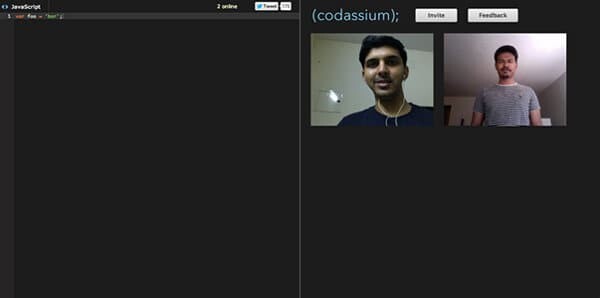Codassium is great not because of what it does but because of who developed it.
I’ve been interviewing a lot of companies here already. Most of them startups who decided to build a business around WebRTC. This is why when I read about Codassium on TechCrunch, I knew I had to find out what went behind it – because there is no startup company there – at least not in the classic sense of it.
The company behind Codassium, is Wreally Studios, who likes playing with HTML5 technology and offer services that use HTML5 in a freemium model.

I was lucky enough when Kishore Nallan and Jason Bosco, co-founders of Wreally Studios, were kind enough to spare some time to answer my questions after being Tech Crunched.
What is Wreally Studios all about?
We build simple web apps that solve specific pain points using bleeding-edge technology. We’re passionate about the real time web.
Why have you decided then to build a WebRTC based service?
WebRTC makes it possible to do real-time streaming which was previously only possible either through Flash or using plugins. It’s an exciting piece of technology and we wanted to build something that was previously either not possible or expensive to get it right.
What can Codassium be used for?
Codassium is great for conducting technical interviews. Often, you would like to see how a candidate goes about solving a problem and if possible, even solve the problem together with the candidate. Codassium allows you to do that without shuttling between 2 different apps (one for video conferencing and the other for coding).
What do you use on the client side?
We use backbone.js for organizing the client-side JavaScript. It helps to keep our code modular. The real-time collaborative editor is built on top of share.js, which is a neat library for writing editors with live editing.
How did you implement the backend of Codassium?
Codassium’s backend is powered by node.js. We use redis for persisting the state. The initial handshake between the clients is done using socket.io, and once that’s done, the actual video streaming happens directly between the clients.
What is the business model you have in place for the things you do at Wreally Studios?
We have had good success with the freemium model. We keep a basic version of all our apps for free, forever. Apart from helping us learn more about our target audience, a free version allows us to gather feedback from everyone.
Any plans on monetizing Codassium?
We are currently gathering feedback from our users. If we feel that there is enough interest for a paid product that addresses more pain points, we’re definitely going to tackle that. If you’re reading this, and think you have some feedback for us, do get in touch with us.
What’s next for Wreally Studios and Codassium?
As always, a lot of hard work! As for Codassium, we are collating all the feedback we’ve received and are prioritizing them to streamline most if not all of them into a cohesive product. As we work on Codassium and our other products, if we stumble on a pain-point that we could solve, that’ll be our next product. And then we iterate.
–
The interviews are intended to give different viewpoints than my own – you can read more WebRTC interviews.
